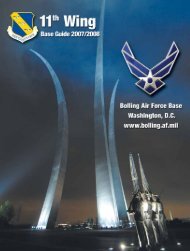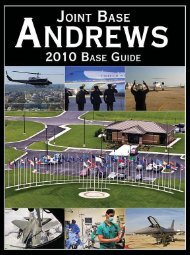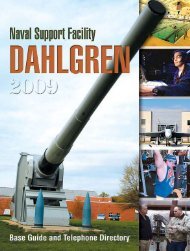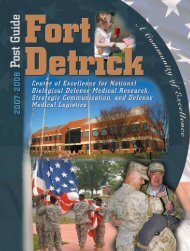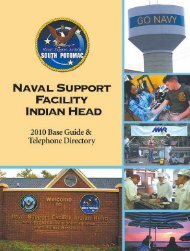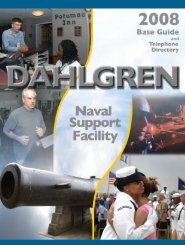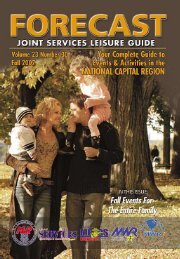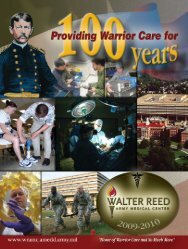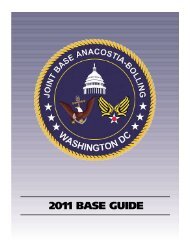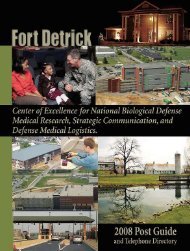About Naval Air Station Patuxent River - DCMilitary.com
About Naval Air Station Patuxent River - DCMilitary.com
About Naval Air Station Patuxent River - DCMilitary.com
Create successful ePaper yourself
Turn your PDF publications into a flip-book with our unique Google optimized e-Paper software.
Squadron Eight, then known as the<br />
Oceanographic <strong>Air</strong> Survey Unit, was<br />
home-ported here in 1965, and Fleet <strong>Air</strong><br />
Reconnaissance Squadron Four was<br />
established here in 1968 from a Take<br />
Charge and Move Out (TACAMO)<br />
detachment left behind by <strong>Naval</strong> <strong>Air</strong><br />
Transport Squadron One when that unit<br />
moved to Norfolk, Va.<br />
Three divisions of the test center,<br />
Flight Test, Service Test and Weapons<br />
Systems Test, gave up assets to enable<br />
the Technical Support Division to form<br />
in 1967. Automation of NATC’s data<br />
processing brought the Computer<br />
Services Division on line in 1968.<br />
In the 1970s the ASW squadrons<br />
began leaving <strong>Patuxent</strong> <strong>River</strong> for<br />
NAS Brunswick, Maine, and NAS<br />
Jacksonville, Fla. VP-30 was the last to<br />
go in 1975.<br />
Helping offset the squadron departures,<br />
<strong>Air</strong> Test and Evaluation Squadron<br />
One moved here from Key West, Fla.,<br />
in 1973 and the <strong>Naval</strong> Aviation Logistics<br />
Center was formed in 1977.<br />
Principal Site<br />
Testing Born<br />
A sweeping reorganization took<br />
place in 1975, preparing NATC for its<br />
role as the <strong>Naval</strong> <strong>Air</strong> Systems<br />
Command’s principal site for development<br />
testing. Under the plan, Flight<br />
Test, Service Test and Weapons Systems<br />
Test divisions were disestablished and<br />
new directorates were formed to<br />
evaluate aircraft by type and mission.<br />
The new NATC was <strong>com</strong>prised of<br />
Strike <strong>Air</strong>craft, Antisubmarine <strong>Air</strong>craft,<br />
Rotary Wing <strong>Air</strong>craft and Systems<br />
Engineering test directorates. The<br />
Computer Services and Technical<br />
Support directorates and the U.S. <strong>Naval</strong><br />
Test Pilot School remained intact.<br />
Reliability and maintainability<br />
became the watchwords in the acquisition<br />
process and NATC adopted a reliability-by-design<br />
philosophy. Computers<br />
were having a profound effect on airplanes<br />
and their systems, and testing by<br />
simulation as well as by flight was<br />
Our Rich Heritage<br />
be<strong>com</strong>ing an economic necessity.<br />
A major upgrading of test facilities<br />
began in the late 1970s with some of the<br />
largest construction appropriations in the<br />
history of the base. Reflecting changes<br />
spurred by this technological growth, the<br />
1980s saw the Computer Services<br />
Directorate be<strong>com</strong>e the Computer<br />
Sciences Directorate, the Technical<br />
Support Directorate be<strong>com</strong>e the Range<br />
Directorate and the Antisubmarine <strong>Air</strong>craft<br />
Test Directorate be<strong>com</strong>e the Force<br />
Warfare <strong>Air</strong>craft Test Directorate.<br />
Navy<br />
Realignment<br />
Brings NAWCAD<br />
In 1991, the Navy began consolidating<br />
its technical capabilities to improve<br />
its products and services, resulting in<br />
the creation of four large warfare<br />
centers. One of these, the <strong>Naval</strong> <strong>Air</strong><br />
Warfare Center, located in Washington,<br />
D.C., has integrated sites and capabilities<br />
to improve services to the fleet and<br />
sponsors. NAWC streamlined its<br />
resources into two divisions: the<br />
<strong>Air</strong>craft Division located at <strong>Patuxent</strong><br />
<strong>River</strong> and the Weapons Division at<br />
China Lake, Calif.<br />
The standup of the NAWC <strong>Air</strong>craft<br />
Division at Pax <strong>River</strong> took place Jan. 1,<br />
1992; thus beginning its role as the<br />
Navy’s full spectrum research, development,<br />
test and evaluation, engineering<br />
and fleet support center for air platforms.<br />
NAWCAD integrated the <strong>Naval</strong><br />
<strong>Air</strong> Test Center along with the <strong>Naval</strong> <strong>Air</strong><br />
Development Center, Warminster, Pa.;<br />
<strong>Naval</strong> <strong>Air</strong> Engineering Center,<br />
Lakehurst, N.J.; <strong>Naval</strong> <strong>Air</strong> Propulsion<br />
Center, Trenton, N.J.; and the <strong>Naval</strong><br />
Avionics Center, Indianapolis.<br />
Growth Continues<br />
Major plant improvements have been<br />
made and new state-of-the-art laboratories<br />
have been added during the last<br />
two decades. Such new additions as the<br />
Manned Flight Simulator, the <strong>Air</strong>craft<br />
Anechoic Test Facility, the <strong>Air</strong> Combat<br />
Environment Test and Evaluation<br />
Facility, the <strong>Air</strong>craft Test and Evaluation<br />
Facility, the Capt. Steven A. Hazelrigg<br />
Flight Test Facility, the U.S. <strong>Naval</strong> Test<br />
Pilot School academic building and an<br />
Aviation Survival Training Center pool<br />
facility and a new <strong>Air</strong> Traffic Control<br />
Tower have significantly improved<br />
aviation safety and enhanced<br />
simulation capabilities.<br />
In recent years, construction has<br />
brought a Child Care Center, Family<br />
Services Center, new family housing, a<br />
Navy Lodge, and a multi-million dollar<br />
Commissary and Navy Exchange.<br />
Improvements have been made to<br />
the air station’s runways, hangars and<br />
bachelor quarters.<br />
Relocated employees from NAWCAD<br />
sites at Warminster, Pa., Trenton, N.J.,<br />
and the <strong>Naval</strong> <strong>Air</strong> Systems Command<br />
Headquarters in Crystal City, Va., now<br />
call <strong>Patuxent</strong> <strong>River</strong> home.<br />
A Site Rich<br />
in History<br />
The station location is closely<br />
associated with the early history of<br />
Maryland. The first settlers in the<br />
original Maryland colony landed at the<br />
mouth of the St. Mary’s <strong>River</strong> in 1634<br />
and established the settlement of St.<br />
Mary’s City about seven miles from the<br />
station’s Gate 2.<br />
Before the Navy came, there was a<br />
small <strong>com</strong>munity called Pearson in the<br />
area of the former Navy Exchange gas<br />
station near taxiway Alpha and Cedar<br />
Point Road. Pearson consisted of a few<br />
residences, a post office, a store, an<br />
automobile dealer (Bell Motor<br />
Company) and Cedar Point Methodist<br />
Church.<br />
The major farms in the area<br />
belonged to the Johnson, Young and<br />
Weschler families. These three farms<br />
included three 17th century plantations<br />
known as Eltonhead Manor (1648),<br />
Susquehanna (1649) and Mattapany-<br />
Sewall (1663).<br />
The Johnson farm consisted of nearly<br />
500 acres of prime farmland located 15<br />
Where the Future of <strong>Naval</strong> Aviation Begins



